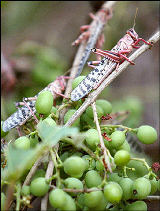Locusts invade flood-hit fields in Sudan
September 6, 2007 (KHARTOUM) — Desert locusts have invaded flood-hit regions of Sudan, bringing fresh misery to farmers already struggling with downpours and a rise in water-borne disease, officials said on Thursday.

A Sudanese agriculture official said Khartoum was sending fast-response teams to four regions — one just 90 km (56 miles) northwest of the capital Khartoum — where locusts have been seen laying eggs or hatching.
Wegdan Abdel Rahman, from the FAO’s office in north-eastern Kassala region, said farmers had been bringing in reports of devastated crops.
“The farmers said the locusts had eaten everything, pasture and sorghum,” she said.
“Of course this is very worrying,” said Rabie Khalil, director of the Ministry of Agriculture and Forestry’s Locust Control and Research Centre.
The locusts have appeared in areas heavily hit by floods and the spread of disease. The worst floods in Sudan in living memory have already killed 122 people, destroyed over 50,000 hectares (125,000 acres) of agricultural land and killed some 36,000 heads of livestock.
On Wednesday, a World Health Organisation official said acute watery diarrhoea spread by flood waters in Kassala and other parts of eastern Sudan has killed 58 people and left nearly 1,000 others ill.
The FAO’s global Locust Watch team on Monday warned that immature swarms of desert locusts, already active in Yemen, could move across the Red Sea into Eritrea and Sudan.
Khalil, of Sudan’s Locust Centre, said he would not know the full extent of the Sudanese situation until his teams reported back over the weekend.
“We have had good early warning. The government is standing by with funds,” he said, adding that without proper spraying, the locusts could turn into full blown swarms by October.
Large numbers of locusts have been spotted in northwest of Khartoum in the North Kordofan region, the northern River Nile region, close to the Eritrean border in Kassala and the Tokar Delta leading into the Red Sea.
(Reuters)
